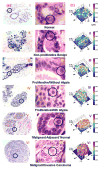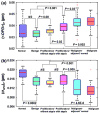Nuclear nano-morphology markers of histologically normal cells detect the "field effect" of breast cancer
- PMID: 22706633
- PMCID: PMC3566261
- DOI: 10.1007/s10549-012-2125-2
Nuclear nano-morphology markers of histologically normal cells detect the "field effect" of breast cancer
Abstract
Accurate detection of breast malignancy from histologically normal cells ("field effect") has significant clinical implications in a broad base of breast cancer management, such as high-risk lesion management, personalized risk assessment, breast tumor recurrence, and tumor margin management. More accurate and clinically applicable tools to detect markers characteristic of breast cancer "field effect" that are able to guide the clinical management are urgently needed. We have recently developed a novel optical microscope, spatial-domain low-coherence quantitative phase microscopy, which extracts the nanoscale structural characteristics of cell nuclei (i.e., nuclear nano-morphology markers), using standard histology slides. In this proof-of-concept study, we present the use of these highly sensitive nuclear nano-morphology markers to identify breast malignancy from histologically normal cells. We investigated the nano-morphology markers from 154 patients with a broad spectrum of breast pathology entities, including normal breast tissue, non-proliferative benign lesions, proliferative lesions (without and with atypia), "malignant-adjacent" normal tissue, and invasive carcinoma. Our results show that the nuclear nano-morphology markers of "malignant-adjacent" normal tissue can detect the presence of invasive breast carcinoma with high accuracy and do not reflect normal aging. Further, we found that a progressive change in nuclear nano-morphology markers that parallel breast cancer risk, suggesting its potential use for risk stratification. These novel nano-morphology markers that detect breast cancerous changes from nanoscale structural characteristics of histologically normal cells could potentially benefit the diagnosis, risk assessment, prognosis, prevention, and treatment of breast cancer.
Conflict of interest statement
Figures






Similar articles
-
Investigation of nuclear nano-morphology marker as a biomarker for cancer risk assessment using a mouse model.J Biomed Opt. 2012 Jun;17(6):066014. doi: 10.1117/1.JBO.17.6.066014. J Biomed Opt. 2012. PMID: 22734770 Free PMC article.
-
Assessment of nuclear nanomorphology marker to improve the detection of malignancy from bile duct biopsy specimens.Am J Clin Pathol. 2014 Jun;141(6):884-91. doi: 10.1309/AJCPXQD0NSJNK0CX. Am J Clin Pathol. 2014. PMID: 24838334 Free PMC article.
-
Malignancy-associated changes in the breast. Changes in chromatin distribution in epithelial cells in normal-appearing tissue adjacent to carcinoma.Anal Quant Cytol Histol. 1995 Feb;17(1):62-8. Anal Quant Cytol Histol. 1995. PMID: 7766270
-
Fourier phase based depth-resolved nanoscale nuclear architecture mapping for cancer detection.Methods. 2018 Mar 1;136:134-151. doi: 10.1016/j.ymeth.2017.10.011. Epub 2017 Nov 7. Methods. 2018. PMID: 29127043 Free PMC article. Review.
-
Quantitative evaluation of malignant potential of early breast cancer using high resolution image cytometry.J Cell Biochem Suppl. 1993;17G:107-13. doi: 10.1002/jcb.240531121. J Cell Biochem Suppl. 1993. PMID: 8007688 Review.
Cited by
-
Investigation of nanoscale structural alterations of cell nucleus as an early sign of cancer.BMC Biophys. 2014 Feb 10;7(1):1. doi: 10.1186/2046-1682-7-1. BMC Biophys. 2014. PMID: 24507508 Free PMC article.
-
Inverse scattering for reflection intensity phase microscopy.Biomed Opt Express. 2020 Jan 14;11(2):911-926. doi: 10.1364/BOE.380845. eCollection 2020 Feb 1. Biomed Opt Express. 2020. PMID: 32206398 Free PMC article.
-
Disorder strength measured by quantitative phase imaging as intrinsic cancer marker in fixed tissue biopsies.PLoS One. 2018 Mar 21;13(3):e0194320. doi: 10.1371/journal.pone.0194320. eCollection 2018. PLoS One. 2018. PMID: 29561905 Free PMC article.
-
Investigation of depth-resolved nanoscale structural changes in regulated cell proliferation and chromatin decondensation.Biomed Opt Express. 2013 Apr 1;4(4):596-613. doi: 10.1364/BOE.4.000596. Epub 2013 Mar 22. Biomed Opt Express. 2013. PMID: 23577294 Free PMC article.
-
Tissue spatial correlation as cancer marker.J Biomed Opt. 2019 Jan;24(1):1-6. doi: 10.1117/1.JBO.24.1.016502. J Biomed Opt. 2019. PMID: 30666854 Free PMC article.
References
-
- Kopelovich L, Henson DE, Gazdar AF, Dunn B, Srivastava S, Kelloff GJ, Greenwald P. Surrogate anatomic/functional sites for evaluating cancer risk: an extension of the field effect. Clin Cancer Res. 1999;5(12):3899–3905. - PubMed
-
- Slaughter DP, Southwick HW, Smejkal W. Field cancerization in oral stratified squamous epithelium; clinical implications of multicentric origin. Cancer. 1953;6(5):963–968. - PubMed
-
- Chai H, Brown RE. Field effect in cancer-an update. Ann Clin Lab Sci. 2009;39(4):331–337. - PubMed
Publication types
MeSH terms
Substances
Grants and funding
LinkOut - more resources
Full Text Sources
Medical

